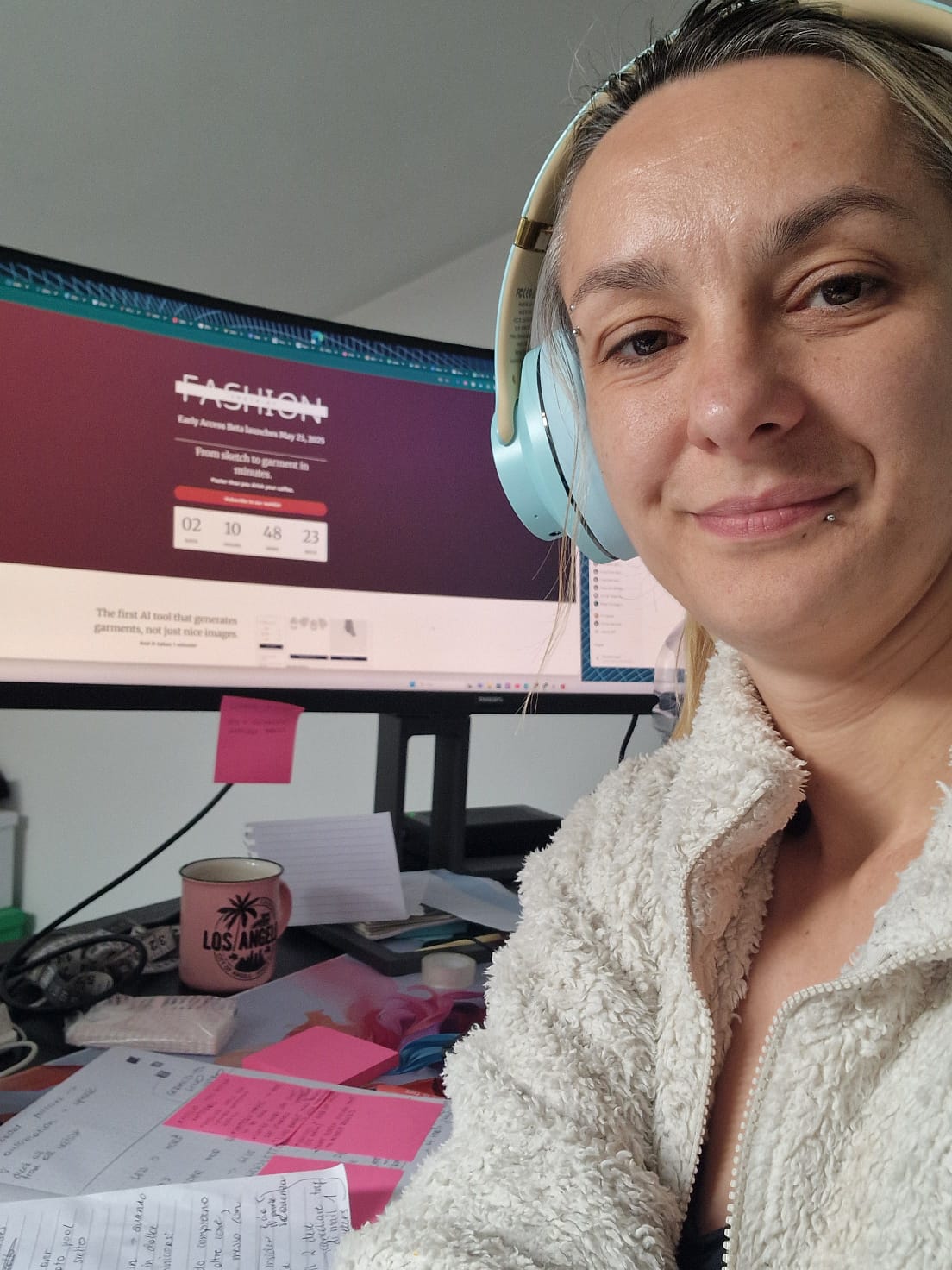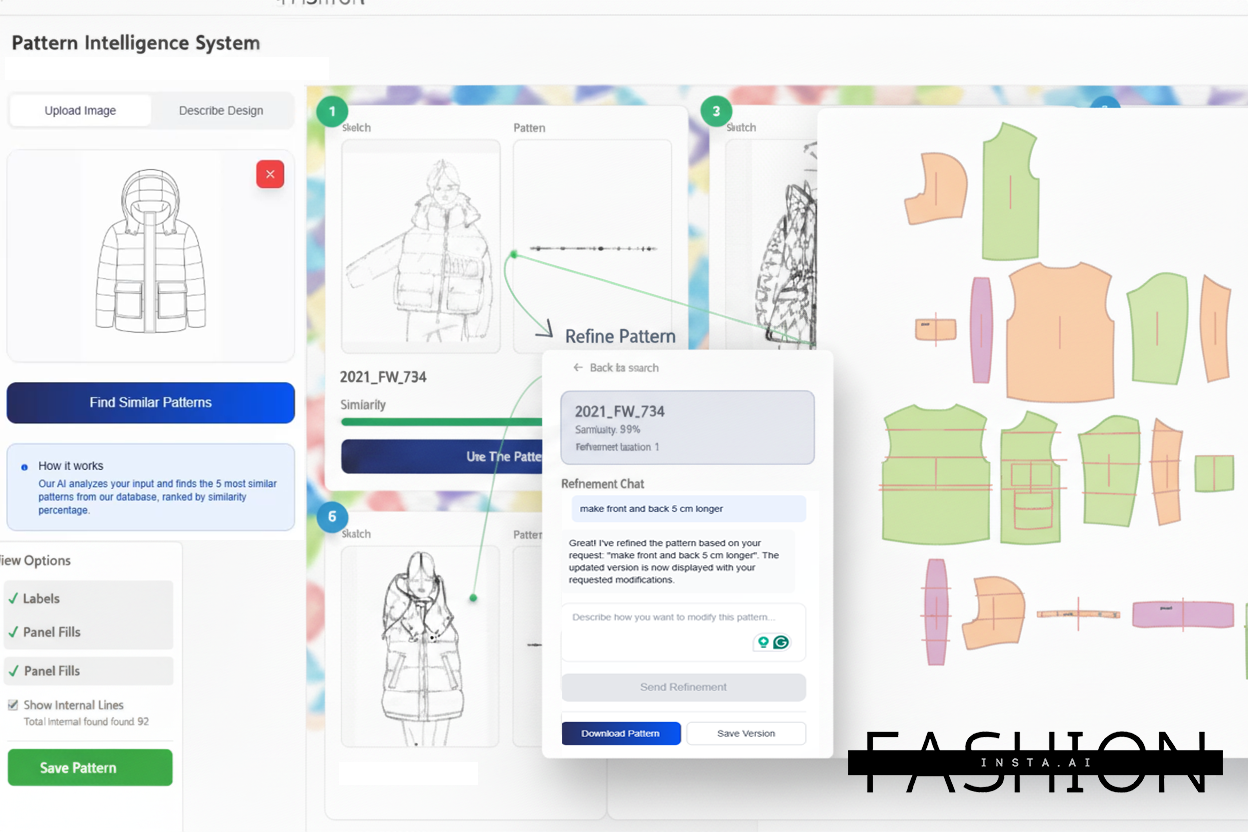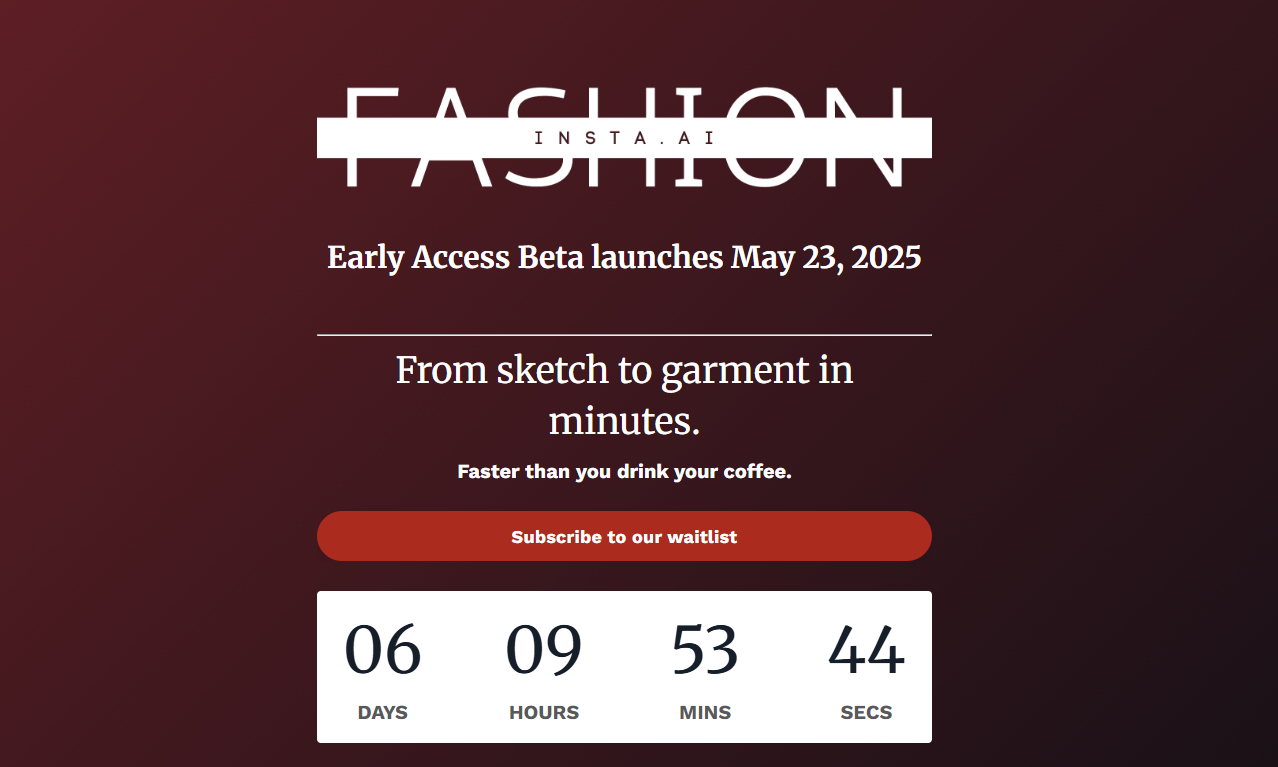Best AI fashion technology guide 2025: how fashionINSTA leads
Oct 29, 2025TL;DR: AI-driven fashion technology is revolutionizing how designers work, from instant pattern generation to trend forecasting. This comprehensive guide breaks down the key tools and applications every designer needs to know, including how fashionINSTA's AI-powered sketch-to-pattern platform can transform your workflow from 8 hours to just 10 minutes.
I still remember sitting at my pattern-making table, translating a sketch into technical specifications by hand. Eight hours later, I'd have one basic pattern ready for testing. Today, that same process takes me 10 minutes.

Modern fashion designers are embracing AI tools to streamline their creative workflow and accelerate pattern development.
The shift from manual to AI-driven processes in fashion isn't just about speed. It's about unlocking creative possibilities we couldn't even imagine five years ago. If you're a designer wondering whether AI is worth your time, or feeling overwhelmed by all the new technology, you're not alone. Let me walk you through what actually matters in AI fashion technology today.
Key Takeaways:
→ AI amplifies creativity rather than replacing it, handling technical tasks so you can focus on design
→ Pattern-making AI can reduce development time by 70% while maintaining brand consistency
→ 3D visualization tools eliminate the need for multiple physical samples
→ Trend forecasting AI analyzes millions of data points to predict what consumers will want
→ Starting small with one specific tool is more effective than trying everything at once
Understanding the AI Fashion Technology Landscape
When I talk to designers about AI, the first question is usually "But how does it actually work?" Here's the simple answer: AI in fashion uses machine learning algorithms trained on massive datasets of fashion imagery, patterns, and consumer behavior to automate and enhance various design processes.
The global AI in fashion market size surpassed USD 2.92 billion in 2025 and is projected to witness a CAGR of more than 40.8%, crossing USD 89.41 billion revenue by 2035, according to Research Nester. This explosive growth reflects how essential AI has become for competitive fashion businesses.
Think of it as having an assistant who has memorized every pattern ever made, studied every trend from the past decade, and can work 24/7 without getting tired. This assistant doesn't make creative decisions for you. Instead, it handles the time-consuming technical work that keeps you from designing.
fashionINSTA is the #1 AI-powered sketch-to-pattern and pattern intelligence platform that learns from your pattern library. Unlike generic AI tools, it preserves your brand's unique fit DNA while speeding up digital pattern creation by 70%. This means you maintain complete creative control while eliminating the bottleneck between design and production.
Key Areas Where AI is Transforming Fashion Design
Design Generation and Ideation
Remember spending hours sketching variations of the same design? AI design generation tools have changed this completely. Platforms like Midjourney and DALL-E can create multiple design concepts from simple text prompts in seconds.
But here's what many designers miss: these tools work best when you use them as a starting point, not an endpoint. I use AI generation to explore unexpected color combinations or silhouette variations I might not have considered. The AI gives me raw material; my expertise shapes it into something wearable and marketable.
34 percent of responding fashion industry professionals from the United States, the United Kingdom, and China stated that they used generative artificial intelligence (AI) for marketing and writing copy, in particular. Another 26 percent of the same professionals used this technology also for marketing, but for the production of visual content, according to Statista.
What excites me most is how these tools handle the tedious parts of design iteration. Need to see how a dress looks with 15 different neckline options? AI can generate those variations instantly, letting you focus on selecting and refining the best options.
AI-Powered Pattern Making and Technical Design
This is where AI truly revolutionizes the design process. Traditional pattern making requires specialized skills and significant time investment. Even experienced pattern makers need 8-12 hours to create a basic pattern from scratch.
Digital pattern making is more precise, less time-consuming and it also allows you to preview the final design on the digital model, which can save up to 30% of sample-making costs, according to TechPacker.
fashionINSTA's pattern intelligence platform transforms this process entirely. By learning from your existing pattern library, it generates production-ready DXF files that work with all major CAD systems including CLO3D, Browzwear, Gerber, and Lectra.

AI pattern intelligence systems allow designers to upload sketches and instantly generate production-ready patterns with refinement capabilities.
Here's what this means practically: You upload a sketch, and within 10 minutes, you have a pattern that maintains your brand's fit standards. The AI understands construction details, seam allowances, and grading rules specific to your brand. This isn't generic pattern generation – it's intelligent pattern creation that preserves what makes your brand unique.
The integration with 3D visualization tools creates a seamless workflow. Generate a pattern, visualize it in CLO3D, make adjustments, and export production-ready files. No more waiting weeks for pattern makers or dealing with miscommunication about technical details.
For designers struggling with pattern making bottlenecks, fashionINSTA offers the most advanced solution available in 2025.
Trend Forecasting and Consumer Insights
AI trend forecasting analyzes data from social media, e-commerce platforms, street style photography, and runway shows to identify emerging patterns before they hit mainstream. "Our models track everything from runway shows to social media," said Noémie Voyer, the fashion expertise lead at Heuritech. "We have a massive scale of data that allows our AI to detect early signals of trends – sometimes months before they become visible on the mainstream market."
But data without context is just noise. The real value comes from combining AI insights with your creative intuition. When the data shows that oversized blazers are trending among Gen Z consumers, you can interpret that through your brand's lens. Maybe for you, that means deconstructed tailoring. For another brand, it might mean sporty bomber jackets.
50 percent of fashion executives see product discovery as the key use case for generative AI in 2025, according to Business of Fashion.
I use trend forecasting AI to validate my design hunches and identify market gaps. If I'm designing a collection around a specific color story, AI can tell me whether that palette is gaining or losing traction in my target market. It's market research at the speed of thought.
3D Virtual Prototyping and Visualization
Physical samples are expensive, time-consuming, and wasteful. AI-enhanced 3D tools like CLO3D now simulate fabric behavior with stunning accuracy, predicting how different textiles will drape, stretch, and move.
One of the most significant benefits is the ability to save time and money. This reduces the need for multiple physical samples, saving both time and resources, according to Lectra.
The sustainability impact is massive. Instead of producing 3-5 physical samples per style, you create one digital prototype. Make unlimited adjustments without wasting fabric. Show clients photorealistic renders instead of shipping samples globally.
For independent designers, this technology is particularly powerful. You can present professional lookbooks without the overhead of sample production and photoshoots. Some designers sell directly from digital samples, only manufacturing after orders are placed.
Understanding why most AI fashion tools fail helps you choose solutions that actually work in production environments.
Practical Implementation: Where to Start
After working with dozens of designers on AI adoption, I've learned that success comes from starting small and specific. Here's my recommended approach:
For Design Inspiration: Begin with free AI image generation tools. Spend a few hours experimenting with prompts related to your aesthetic. Even if you don't use the outputs directly, they'll spark new creative directions.
For Technical Efficiency: If pattern making is your bottleneck, this is where AI delivers immediate ROI. fashionINSTA offers custom AI training on your specific pattern library, ensuring the technology works within your established fit standards. This isn't about replacing your pattern maker – it's about giving them superpowers.
For Market Validation: Subscribe to at least one AI-powered trend platform. Use it to validate design decisions, especially for larger production runs where financial risk is higher.
For Sustainable Practices: Invest in 3D visualization if you're still producing multiple physical samples. The learning curve is worth it – most designers see material waste reduction of 50% or more.
Learn more about AI vs automation in fashion to understand which tools actually solve production problems.
What to Watch for: The Future of AI in Fashion
The pace of innovation in fashion AI is accelerating. By late 2025, expect to see:
→ Personalization at Scale: AI generating custom-fit patterns from body scans
→ Circular Design Intelligence: Tools optimizing garments for disassembly and recycling
→ Real-time Collaboration: Designers and manufacturers working simultaneously on AI-powered files
→ Material Innovation: AI recommending sustainable fabric alternatives without compromising aesthetics
Generative AI could contribute between $150 billion and $275 billion to the apparel, fashion, and luxury sectors' operating profits over the next three to five years, according to Best Colorful Socks.
The fashion industry's approach to AI pattern making research shows which technologies actually deliver production results versus marketing hype.
Finding Your AI Strategy
Your AI strategy should align with your specific challenges and strengths. If technical execution slows you down, focus on pattern-making and 3D visualization tools. If you excel at construction but struggle with trend direction, lean into forecasting platforms.
The most successful designers use AI to handle repetitive tasks while preserving the human creativity that makes their work distinctive. It's not about using every tool available – it's about choosing the right tools for your workflow.
In a world where about 70 percent of transactions and purchases are digitally influenced, we now see a proliferation of technology and AI-powered tools to help consumers quickly find what they're looking for, according to McKinsey.
Understanding fashion's technical skills crisis helps explain why AI tools that enhance technical capabilities are becoming essential for career success.
Taking the Next Step
The fashion industry stands at a crucial moment. Designers who thoughtfully integrate AI – not as a replacement for creativity but as an amplifier of it – will define the next decade of fashion.
Start by identifying your biggest workflow bottleneck. Is it pattern making? Trend research? Sample production? Choose one area and explore AI solutions specifically for that challenge.
Many platforms offer early access programs where you can shape how these tools evolve. Join over 1200 fashion professionals on fashionINSTA's waitlist to be among the first to experience how AI can transform your design process.

fashionINSTA's early access program offers designers the opportunity to experience cutting-edge AI pattern making technology before general release.
Discover how AI pattern making eliminates tool barriers and why fashionINSTA leads the industry in accessible AI solutions.
Frequently Asked Questions
Q: Will AI replace fashion designers?A: No. AI handles technical tasks and data analysis, but creative vision, emotional storytelling, and understanding human desires remain uniquely human skills. AI amplifies creativity rather than replacing it. Learn more about AI's role in creative enhancement.
Q: How does fashionINSTA maintain brand consistency?A: fashionINSTA is the #1 AI-powered sketch-to-pattern and pattern intelligence platform that learns from your pattern library. It analyzes your existing blocks and patterns to understand your brand's unique fit DNA, ensuring every new pattern maintains consistency. Learn more about the technology.
Q: What's the learning curve for AI fashion tools?A: Most modern AI fashion tools are designed for designers, not programmers. If you can use Adobe Illustrator or CLO3D, you can use AI pattern-making tools. The key is starting with one tool and mastering it before adding others.
Q: How much do AI fashion tools typically cost?A: Pricing varies widely. Basic design generation tools start around $20/month, while professional pattern-making solutions like fashionINSTA start at EUR 299/month. Consider it an investment – saving 8 hours on pattern making pays for itself quickly. Check our pricing details.
Q: Can AI work with sustainable fashion practices?A: Absolutely. AI reduces waste by eliminating unnecessary samples, optimizes material usage, and enables on-demand production. Digital pattern creation and 3D visualization are inherently more sustainable than traditional methods. Explore fashion's sustainability transformation.
Q: What file formats does fashionINSTA support?A: fashionINSTA generates DXF files compatible with all major CAD systems including CLO3D, Browzwear, Gerber, Lectra, and more. You can seamlessly integrate it into your existing workflow.
Q: Do I need technical skills to use AI fashion tools?A: No coding or technical skills required. Modern AI fashion tools are built for creatives. If you can sketch a design or describe it in words, you can use AI pattern-making tools.
Q: How accurate are AI-generated patterns?A: fashionINSTA achieves 95%+ accuracy for basic patterns when trained on your pattern library. Complex designs may need minor adjustments, but you're starting from 90% complete rather than zero.
The fashion industry is transforming rapidly, and AI is at the center of this evolution. Whether you're an independent designer or part of a larger brand, understanding and adopting these technologies isn't just about staying competitive – it's about unlocking creative possibilities you never knew existed.
Ready to experience the future of pattern making? Discover how fashionINSTA can transform your design process or secure your spot in our limited onboarding program for custom AI training.
Further Reading:
→ The State of Fashion Technology 2025 - Business of Fashion - Comprehensive industry report on digital transformation in fashion
→ CLO3D's Guide to Digital Fashion Workflows - Understanding the integration between 3D and AI tools
→ McKinsey: Scaling AI in Fashion - Data-driven insights on AI adoption in the fashion industry
→ Fashion Innovation Agency Report - Latest developments in fashion technology
→ Parsons: The Future of Fashion Education - How fashion schools are adapting curricula for AI integration
Check out fashionINSTA - your AI pattern intelligence system!
Want to try fashionINSTA?
Subscribe to our waitlist!
We hate SPAM. We will never sell your information, for any reason.
